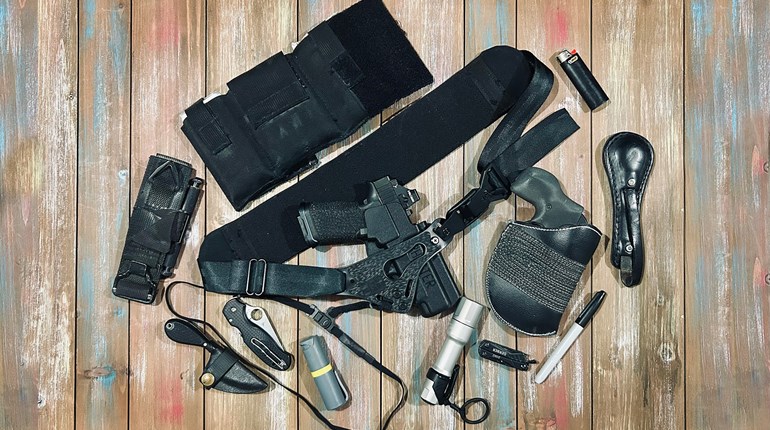
The venerable B-8 target was designed many decades ago for NRA bullseye matches, yet it is as popular as ever today for defensive minded shooters as well. It is a design that is simple, useful, and for which there are many excellent practice drills that can help us improve our shooting skills. For my practice I typically use the B-8 Replacement Center target, which is often designated “B-8C.” The B-8C has many advantages. Its dimensions are an X-ring that is 1.695 inches in diameter, a larger 10-ring measuring 3.36 inches and a 9-ring at 5.54 inches. This portion of the target is black and makes up the bullseye, and then an 8-ring measuring 8 inches across that is white or beige depending on the color of the paper stock, providing scoring areas with measurable feedback about our accuracy on one 8.5x11 sheet of paper
The B-8C target provides the opportunity for improvement at all skill levels. Let’s examine some common practice routines and drills shooters of various skills levels can use.
Untimed Fire
For less experienced shooters or for use as a warm up, simply firing a string of shots at a chosen distance under no time pressure is a great place to start. Depending on one’s skill level, a shooter might begin at 3, 5, 7, 10, 15, or even 25 yards. Then fire a set number of rounds at the center of the target, and score your hits based on what number ring they’re in. If a hit is on a scoring line of the target (called a “line break”), count the higher value. This method of using the B-8C for untimed fire is progressive, and if you are able to consistently shoot 100/10x (meaning 10 hits inside the X-ring) at a specific distance, then it may be time to either move further from the target or to add time pressure, which we will discuss more below. It’s important to note that we don’t necessarily need to choose our distances to replicate typical defensive gun use distances. The goal of changing the target distance is to make the target perceptually smaller or larger and increase or decrease the degree of difficulty. We move back to challenge ourselves and improve our accuracy as we are able, and if we can keep our rounds in the black of the B-8 at extended ranges then typical defensive gun use distances are a piece of cake.
5x5 Drill
Distance: 5 yards
Start Position: Low-ready
Round Count: 5 rounds
Accuracy Standard: All rounds inside the black (9-ring)
Par Time: 5 seconds
The 5x5 Drill was developed by firearms instructor Gila Hayes, and is one of my all-time favorites. Technically the drill as designed requires a 5 inch diameter target (versions of which you can also find online), but if you already have a printed stack of B-8C targets on hand already, this is one I like to do using the B-8C. I figure it’s close enough to provide practice value, especially if you can avoid hitting in the outer 1/4 inch of the 9-ring of the B-8. This drill requires a shot timer and involves beginning at the low ready at five yards. At the beep, fire five rounds. The goal is to fire five rounds all inside the black (9-ring) in less than five seconds. Veteran instructor Claude Werner recommends adding an additional layer to this drill by shooting it five times consecutively, for a total of 25 rounds, in an effort to prove consistency. If you can do it five times in a row, it’s not a fluke. Another additional degree of difficulty a shooter can add is to perform the drill from the holster while maintaining the five second par time. If there were one single technical shooting drill I’d encourage every armed citizen who carries daily to practice and strive to master, it would be this one.

The Test
Distance: 10 yards
Start Position: Low-ready
Round Count: 10 rounds
Accuracy Standard: Score 90 or above
Par Time: 10 seconds
“The Test” is a shooting drill developed by Ken Hackathorn. It has a higher degree of difficulty than the 5x5 Drill since it is double the distance, but still requiring a one shot per second time standard. At 10 yards, from the low ready, at the beep fire 10 rounds and score your hits. A passing score is 90/100. If you struggle with The Test, simply decrease the distance and shoot it at seven, five, or even three yards until you’ve can consistently shoot 90-100 and then begin increasing the distance incrementally. To make this drill more challenging, begin from the holster but maintain the 10 second par time.
The Super Test
Distance: 15/10/5 yards
Start Position: Low-ready
Round Count: 30 rounds
Accuracy Standard: Score 270 or above
Par Time: 15/10/5 seconds
The Super Test is a variation of The Test. You begin at 15 yards with 10 rounds loaded, from the low-ready position. You have 15 seconds from the beep to fire 10 rounds. Then move up to the 10 yard line. At the beep, you have 10 seconds to fire 10 rounds. Then move to the five yard line. At the beep, you have 5 seconds to fire 10 rounds. A passing score is 270/300. It’s important to understand however, that this is a very difficult drill. If you struggle to score 270, don’t get discouraged. If you’re in the 200s continue working it. If you’re nowhere close, spend some time working the above drills and untimed fire 15 yards to work on your accuracy, then push the pace as your able. If you want to increase the difficulty, then run this drill from the holster, which is known as the “Advanced Super Test.”
No Fail Shot Drill
Distance: 25 yards
Start Position: Holstered
Round Count: 10 rounds (10 reps of on round from the holster)
Accuracy Standard: All shots inside the black/9-ring
Par Time: 3.5 seconds (You can miss par once of 10 attempts)
This drill was developed by former special operator and instructor Chuck Pressburg, and is the most difficult drill on this list. It is simple, but very, very hard. From 25 yards with your handgun in the holster, set a 3.5 second par time. At the beep, draw and fire one round at the B-8C. Then holster and repeat nine times for a total of 10 rounds fired. For a successful run, all rounds must be inside the black/9-ring, and you must make the par time 9/10 times. Pressburg also designed the drill to be run “cold,” meaning the first rounds fired of the day, and to be run only once a day in order to be considered a successful run, since it is intended to measure “on demand” performance. Successfully completing this drill indicates an extremely high level of technical shooting skill.
Conclusion
Whether you are a less-experienced shooter who needs to work on your accuracy at 3-5 yards under no time pressure, or an experienced and highly skilled shooter who is working on shooting rapidly and accurately at longer distances, the B-8C is an excellent target to enhance your practice. The ability to keep a stack of them in your range bag makes them an inexpensive and convenient resource for improving your technical shooting skills, so try some of these drills next time you go to the range.



































